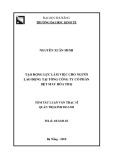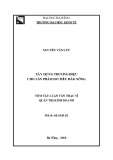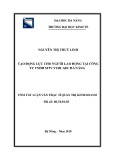
EXISTENCE AND MULTIPLICITY OF WEAK SOLUTIONS FOR
A CLASS OF DEGENERATE NONLINEAR
ELLIPTIC EQUATIONS
MIHAI MIH ˘
AILESCU
Received 11 January 2005; Revised 4 July 2005; Accepted 17 July 2005
The goal of this paper is to study the existence and the multiplicity of non-trivial weak
solutions for some degenerate nonlinear elliptic equations on the whole space RN.The
solutions will be obtained in a subspace of the Sobolev space W1,p(RN). The proofs rely
essentially on the Mountain Pass theorem and on Ekeland’s Variational principle.
Copyright © 2006 Mihai Mih˘
ailescu. This is an open access article distributed under the
Creative Commons Attribution License, which permits unrestricted use, distribution,
and reproduction in any medium, provided the original work is properly cited.
1. Introduction
The goal of this paper is to study a nonlinear elliptic equation in which the divergence
form operator −div(a(x,∇u)) is involved. Such operators appear in many nonlinear dif-
fusion problems, in particular in the mathematical modeling of non-Newtonian fluids
(see [5] for a discussion of some physical background). Particularly, the p-Laplacian op-
erator −div(|∇u|p−2∇u) is a special case of the operator −div(a(x,∇u)). Problems in-
volving the p-Laplacian operator have been intensively studied in the last decades. We just
remember the work on that topic of Jo˜
ao Marcos B. do ´
O[
7], Pfl¨
uger [12], R˘
adulescu and
Smets [14] and the references therein. In the case of more general types of operators we
pointoutthepapersofJo
˜
ao Marcos B. do ´
O[
6]andN
´
apoli and Mariani [4]. On the
other hand, when the operator −div(a(x,∇u)) is of degenerate type we refer to Cˆ
ırstea
and R˘
adulescu [15] and Motreanu and R˘
adulescu [11].
In this paper we study the existence and multiplicity of non-trivial weak solutions to
equations of the type
−diva(x,∇u)=Ᏺ(x,u), x∈RN, (1.1)
where the operator div(a(x,∇u)) is nonlinear (and can be also degenerate), N≥3and
function Ᏺ(x,u) satisfies several hypotheses. Our goal is to show how variational tech-
niques based on the Mountain Pass theorem (see Ambrosetti and Rabinowitz [2]) and
Ekeland’s Variational principle (see Ekeland [8]) can be used in order to get existence of
Hindawi Publishing Corporation
Boundary Value Problems
Volume 2006, Article ID 41295, Pages 1–17
DOI 10.1155/BVP/2006/41295

2 Existence and multiplicity
one or two solutions for equations of type (1.1). Results regarding the multiplicity of so-
lutions have been originally proven by Tarantello [16], but in the case of linear equations
and in a different framework. More precisely, Tarantello proved that the equation
−∆u=|u|4/(N−2)u+Γ(x) (1.2)
has at least two distinct solutions, in a bounded domain of RN(N≥3), provided that
Γ≡ 0issufficiently “small” in a suitable sense.
2. Main results
The starting point of our discussion is the equation
−∆v+b(x)v=f(x,v)x∈RN(2.1)
studied by Rabinowitz in [13]. Assuming that function f(x,v) is subcritical and satisfies
a condition of the Ambrosetti-Rabinowitz type (see [2]) and function b(x)issufficiently
smooth and unbounded at infinity, it is showed in [13]thatproblem(2.1)hasanontrivial
weak solution in the classical Sobolev space W1,2(RN).
Inthecasewhenb(x) is continuous and nonnegative and f(x,v)=h(x)vα+vβis such
that h:RN→Ris some integrable function and 1 <α<2<β<(N+2)/(N−2), N≥3,
Gonc¸alves and Miyagaki proved in [9]thatproblem(2.1) has at least two nonnegative
solutions in a subspace of W1,2(RN). In a similar framework, when f(x,v)=λvα+v2⋆−1
with 0 <α<1and2
⋆=(2N)/(N−2), N≥3 it is shown in [1]thatproblem(2.1)has
a nonnegative solution for λpositive and small enough. Furthermore, in [1]itisalso
proved that in the case N≥4andα=1problem(
2.1) has a nonnegative solution pro-
vided that λis positive and small enough. For more information and connections on (2.1)
the reader may consult the references in [9].
In this paper our aim is to study the problem
−diva(x,∇u)+b(x)
u
p−2u=f(x,u), x∈RN, (2.2)
where N≥3and2≤p<N.
We point out the fact that in the case when a(x,∇u)=|x|α∇u,α∈(0,2) and p=2
problem (2.2) was studied by Mih˘
ailescu and R˘
adulescu in [10]. In that paper the authors
present the connections between such equations and some Schr¨
odinger equations with
Hardy potential and show that (2.2) has a nontrivial weak solution. A discussion of some
physical applications for equations of type (2.2) and a list of papers devoted with the
study of such problems is also included in [10].
In the following we describe the framework in which we will study (2.2).
Consider a:RN×RN→RN,a=a(x,ξ), is the continuous derivative with respect to ξ
of the continuous function A:RN×RN→R,A=A(x,ξ), that is, a(x,ξ)=(d/dξ)A(x,ξ).

Mihai Mih˘
ailescu 3
Suppose that aand Asatisfy the hypotheses below:
(A1) A(x,0)=0forallx∈RN;
(A2) |a(x,ξ)|≤c1(θ(x)+|ξ|p−1), for all x,ξ∈RN,withc1a positive constant and
θ:RN→Ris a function such that θ(x)≥0forallx∈RNand θ∈L∞(RN)∩
Lp/(p−1)(RN);
(A3) there exists k>0suchthat
Ax,ξ+ψ
2≤1
2A(x,ξ)+1
2A(x,ψ)−k|ξ−ψ|p(2.3)
for all x,ξ,ψ∈RN, that is, A(x,·)isp-uniformly convex;
(A4) 0 ≤a(x,ξ)·ξ≤pA(x,ξ), for all x,ξ∈RN;
(A5) there exists a constant Λ>0suchthat
A(x,ξ)≥Λ|ξ|p, (2.4)
for all x,ξ∈RN.
Examples. (1) A(x,ξ)=(1/p)|ξ|p,a(x,ξ)=|ξ|p−2ξ,withp≥2andwegetthep-Laplacian
operator
div|∇u|p−2∇u.(2.5)
(2) A(x,ξ)=(1/p)|ξ|p+θ(x)[(1+|ξ|2)1/2−1], a(x,ξ)=|ξ|p−2ξ+θ(x)(ξ/(1+|ξ|2)1/2),
with p≥2andθa function which verifies the conditions from (A2). We get the operator
div|∇u|p−2∇u+div⎛
⎝θ(x)∇u
1+|∇u|21/2⎞
⎠(2.6)
which can be regarded as the sum between the p-Laplacian operator and a degenerate
form of the mean curvature operator.
(3) A(x,ξ)=(1/p)[(θ(x)2/(p−1) +|ξ|2)p/2−θ(x)p/(p−1)], a(x,ξ)=(θ(x)2/(p−1) +
|ξ|2)(p−2)/2ξ,withp≥2andθa function which verifies the conditions from (A2). We
get the operator
divθ(x)2/(p−1) +|∇u|2(p−2)/2∇u(2.7)
which is a variant of the generalized mean curvature operator, div((1 + |∇u|2)(p−2)/2∇u).
Assume that function b:RN→Ris continuous and verifies the hypotheses:
(B) There exists a positive constant b0>0suchthat
b(x)≥b0>0, (2.8)
for all x∈RN.
In a first instance we assume that function f:RN×R→Rsatisfies the hypotheses:
(F1) f∈C1(RN×R,R), f=f(x,z)and f(x,0)=0forallx∈RN;

4 Existence and multiplicity
(F2) there exist two functions τ1,τ2:RN→R,τ1(x), τ2(x)≥0fora.e.x∈RNand two
constants r,s∈(p−1,(Np−N+p)/(N−p)) such that
fz(x,z)
≤τ1(x)|z|r−1+τ2(x)|z|s−1, (2.9)
for all x∈RNand all z∈R,whereτ1∈Lr0(RN)∩L∞(RN), τ2∈Ls0(RN)∩
L∞(RN), with r0=Np/(Np−(r+1)(N−p)) and s0=Np/(Np−(s+1)(N−p));
(F3) there exists a constant µ>psuch that
0<µF(x,z):=µz
0f(x,t)dt ≤zf(x,z), (2.10)
for all x∈RNand all z∈R\{0}.
Next, we study the problem
−diva(x,∇u)+b(x)|u|p−2u=h(x)|u|q−1u+g(x)|u|s−1u,x∈RN(2.11)
with 1 <q<p−1<s<(Np−N+p)/(N−p)andN≥3.
Our basic assumptions on functions hand g:RN→Rare the following:
(H) h(x)≥0forallx∈RNand h∈Lq0(RN)∩L∞(RN), where q0=Np/(Np−(q+
1)(N−p));
(G) g(x)≥0forallx∈RNand g∈Ls0(RN)∩L∞(RN), where s0=Np/(Np−(s+
1)(N−p)).
Let W1,p(RN) be the usual Sobolev space under the norm
u1=RN|∇u|p+|u|pdx1/p
(2.12)
and consider the subspace of W1,p(RN)
E=u∈W1,p(RN); RN|∇u|p+b(x)|u|pdx < ∞.(2.13)
The Banach space Ecan be endowed with the norm
up=RN|∇u|p+b(x)|u|pdx. (2.14)
Moreover,
u≥m1/p
0u1, (2.15)
with m0=min{1,b0}. Thus the continuous embeddings
EW1,pRNLiRN,p≤i≤p⋆,p⋆=Np
N−p(2.16)
hold true.

Mihai Mih˘
ailescu 5
We say that u∈Eis a weak solution for problem (2.2)if
RNa(x,∇u)·∇ϕdx+RNb(x)|u|p−2uϕ dx −RNf(x,u)ϕdx=0, (2.17)
for all ϕ∈E.
Similarly, we say that u∈Eis a weak solution for problem (2.11)if
RNa(x,∇u)·∇ϕdx+RNb(x)|u|p−2uϕ dx
−RNh(x)|u|q−1uϕ dx −RNg(x)|u|s−1uϕ dx =0,
(2.18)
for all ϕ∈E.
Our main results are given by the following two theorems.
Theorem 2.1. Assuming hypotheses (A1)–(A5), (B) and (F1)–(F3) are fulfilled then prob-
lem (2.2) has at least one non-trivial weak solution.
Theorem 2.2. Assume 1<q<p−1<s<(Np−N+p)/(N−p)and conditions (A1)–
(A5), (B), (H) and (G) are fulfilled. Then problem (2.11) has at least two non-trivial weak
solutions provided that the product h(s+1−p)/(s−q)
Lq0(RN)·g(p−q−1)/(s−q)
Ls0(RN)is small enough.
3. Auxiliary results
In this section we study certain properties of functional T:E→Rdefined by
T(u)=RNA(x,∇u)dx +1
pRNb(x)|u|pdx, (3.1)
for all u∈E. It is easy to remark that T∈C1(E,R)and
T′(u),v=RNa(x,∇u)·∇vdx+RNb(x)|u|p−2uv dx, (3.2)
for all u,v∈E.
Proposition 3.1. Functional Tis weakly lower semicontinuous.
Proof. Let u∈Eand ǫ>0 be fixed. Using the properties of lower semicontinuous func-
tions (see [3, Section I.3]) is enough to prove that there exists δ>0suchthat
T(v)≥T(u)−ǫ,∀v∈Ewith u−v<δ. (3.3)
We remember Clarkson’s inequality (see [3, page 59])
α+β
2
p
+
α−β
2
p
≤1
2|α|p+|β|p,∀α,β∈R.(3.4)








![Hình ảnh học bệnh não mạch máu nhỏ: Báo cáo [Năm]](https://cdn.tailieu.vn/images/document/thumbnail/2024/20240705/sanhobien01/135x160/1985290001.jpg)










![Báo cáo seminar chuyên ngành Công nghệ hóa học và thực phẩm [Mới nhất]](https://cdn.tailieu.vn/images/document/thumbnail/2025/20250711/hienkelvinzoi@gmail.com/135x160/47051752458701.jpg)






